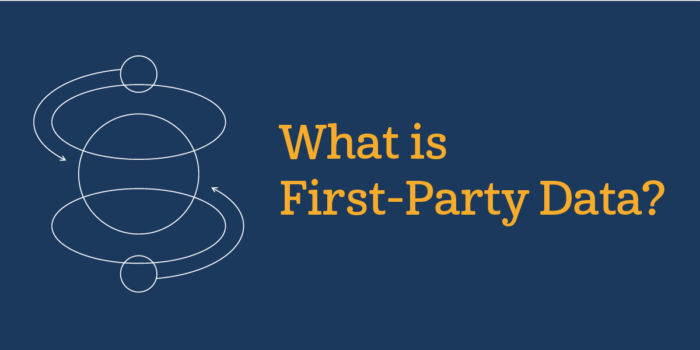
For anyone new to the data scene, first of all — welcome to the party! If there is one thing we love to talk about at Lotame, it’s data. After all, data is everywhere and, when activated properly, it can help businesses launch ROI-driven advertising campaigns.
But how do you collect data? What kind of data should you collect? And, more importantly, what can you actually do with data? Before we can answer any of these questions, we must understand what first-party data is.
What Is First-Party Data?
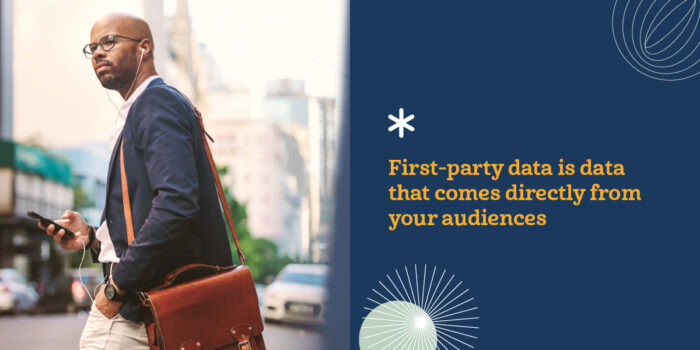
First-party data is data that comes directly from your audiences. You collect it straight from your customers, site visitors, email list subscribers or other people who are interacting directly with your organization. This is the main feature that differentiates it from other types of data, such as second-party and third-party data, which comes from outside sources. Because you collect it directly from your own customers, first-party data is considered high-quality and highly relevant.
Not using your first-party data is a missed opportunity. While other types of data are also valuable, first-party data should be a priority in data analysis because of its relevance and quality. It helps businesses understand their target audience better, locate missed opportunities and create innovative personalized strategies to increase ROI.
The Value of First-Party Data

First-party data is one of the most valuable kinds of data that companies can collect and leverage. Companies can use it to learn more about their current audience’s interests, preferences, characteristics and behaviors. They can then use this information to predict future customer behavior, improve their targeting, enhance their marketing campaigns and personalize their content. Some of the qualities that make first-party data so valuable are its:
- Relevance: Your first-party data is highly relevant to your business because it comes straight from your audience. It gives you insight into how your actual customers and site visitors behave and what their preferences are. With first-party data, you don’t have to guess about what your audience likes — you have the information direct from the source
- Accuracy: Because you collect first-party data straight from the source, it’s likely to be accurate. You minimize the distance between the source of the data and your company, which minimizes the opportunities for errors to occur. It’s also easy to verify the accuracy of first party-data in many cases because you collected it first-hand and facilitated the transactions yourself. Finally, it’s also easier to manage privacy-related issues because you know precisely where the data came from.
- Availability: First-party data is also often readily available to businesses. In many cases, the information is already in a system such as a point-of-sale or CRM system, or it can be easily collected through a data collaboration platform (DCP). You just need to determine how to access it, organize it and put it to use. Customers leave behind valuable information every time they visit your website. You simply need to set up a process to help you collect that data. Because this data is so readily available, gathering it is easier than with many other types of data.
- Cost-effectiveness: Collecting first-party data is exceptionally cost-effective. In many cases, you already have it in your systems, and you simply need to gather it and put it to use. There are some costs associated with collecting and managing your data, but you don’t have to purchase it, unlike second-party and third-party. Not using your first-party data is like leaving money on the table. Because of the quality and relevance of the data, you can also expect to get a lot of value you from it. The low cost and high quality of first-party data result in a high return on your investment.
What Kinds of First-Party Data Can You Collect?
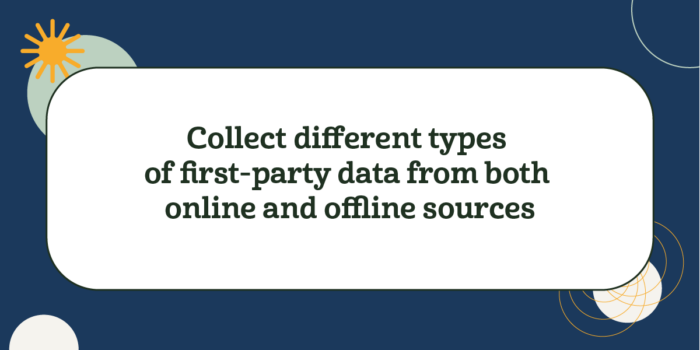
You can collect many different types of first-party data from both online and offline sources.
- Behavioral data from online interactions: With simple website tags, you can automatically gather data about how people interact with your brand online through clicks, views, comments, purchases and other behaviors. This information can give you insights into who is visiting your online properties and what content or products they’re interested in, enabling you to tailor your strategies to your audience’s preferences.
- Subscription data: If people subscribe to receive content from your company, you know they’re interested in your brand. For newspapers, magazines and blogs, these subscribers are an integral part of the business model. For companies that sell other products but have an email list, subscriptions may be part of a marketing effort. By analyzing who subscribes to your content, you can learn more about the types of people who are interested in your company and your content.
- Social data: You can collect information about who follows you on social media and who likes, shares and comments on your posts to give you an idea of who your audience is. You can learn about your audience’s interests, behaviors and preferences by evaluating their profiles, what they post and the other pages they follow. The content of the messages and comments people send you can also give you information about what people think about your brand, content and products.
- Cross-platform data: Today’s global brands and publishers are facing tough challenges around consumer identity and engagement. Lotame Panorama ID is a global pseudonymous identifier that represents a single consumer view across channels. Our powerful ID graph delivers complete, consistent, and compliant data connections to power people-based marketing. Our technology plots, clusters, and shares diverse data connections so brands and publishers can plan, activate, and analyze how they want.
- In-store purchase data: In addition to online purchase data, you can also import data from in-store purchases. By combining your offline sales data with your e-commerce sales data, you can get a more complete understanding of the purchase behaviors of your customers. This can give you insights into which products are most popular and which types of customers prefer which products.
- Survey data: You can also ask customers to give you feedback via paper survey forms, online forms, emails, phone calls and other channels. Ask about your customers’ demographics, their opinions on your products or what kind of website content they prefer.
- Customer feedback data: You can analyze other direct customer feedback channels including comments on your website, phone calls to your customer service agents and messages sent over social media. Both positive and negative feedback is valuable, as you need to know both what is working well and what you need to improve and collect insights into the preferences of different groups of customers.
How Is First-Party Data Used?
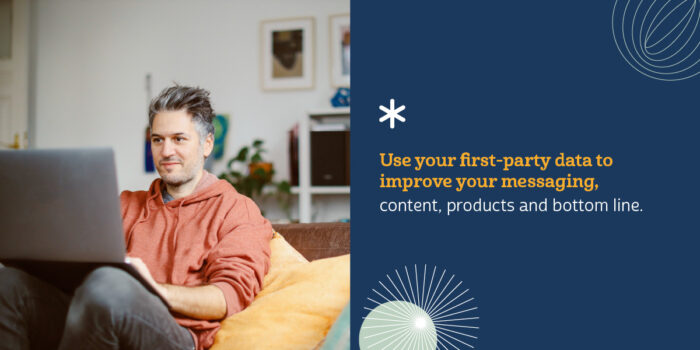
You can use your first-party data in various ways to improve your messaging, content, products and bottom line. When you combine your first-party data with second-party and third-party data, you unlock even more possibilities. Some of the uses of first-party data include:
1. Gain Audience Insights
An improved understanding of your audience allows you to tailor your products and content to their preferences. By analyzing your first-party data, you can uncover insights about your audience’s demographics, interests, preferences and purchase behaviors. A marketer for a clothing company, for example, might find out that shoppers who purchase shoes online tend to buy athletic shoes, while those who shop in a physical store are more likely to buy formal shoes. A publisher might discover that subscribers over 50 years old typically prefer articles, while its teenage subscribers tend to like videos best.
2. Predict Customer Behavior
Analyzing your first-party data can provide you with insights that allow you to predict the behavior of your audience. You can use this information to inform the targeting of your marketing campaigns. If you know that a given customer clicked on one of your ads, there’s a higher chance that they’ll purchase your product as compared to someone who chose not to interact with your ad. If a website visitor’s demographic information and interests match up with those of most of your subscribers, there’s a greater chance they’ll become a subscriber too.
3. Personalize Marketing Campaigns or Content
You can also use first-party data to personalize your ads or content so that it aligns with individual audience members’ interests and preferences. Making your content and ads more relevant to your audience members can help boost sales, subscriber counts and engagement.
Looking at the videos a certain subscriber watched in the past gives a publisher insight into the topics that user is interested in. This information allows the publisher to show videos about those topics on the homepage when that subscriber signs in. If someone visits the website who has similar demographic information to that subscriber, the publisher could use this information to predict what topics they might be interested in.
Marketers can use first-party data similarly. By tracking what types of ads a user interacts with, they can determine what the user’s preferences are and start showing them ads that appeal to them more.
4. Effective Audience Retargeting
First-party data can also inform your audience retargeting strategy, which involves delivering ads to people who visited your website but didn’t convert. It’s normal that many of your prospects won’t convert the first time they see one of your ads or visit your site. There is a higher chance, however, that these prospects will eventually convert, so you want to keep targeting ads to them.
You can customize these retargeted ads based on actions the user took on your website. For example, if they placed an item in their cart but didn’t purchase it, you could show them ads for that particular product. If they read an article on a given topic but didn’t click subscribe, you can send them ads featuring articles that are similar to the one they read.
5. Target New Audiences
Another valuable use of first-party data in marketing is finding new audiences. Using our Audience Optimizer tool, you can find new users who are similar to those in your current audience. Because these users are similar to your current customers, there’s a higher chance that they’ll make a purchase or sign up to receive your content.
How Do You Collect First-Party Data?
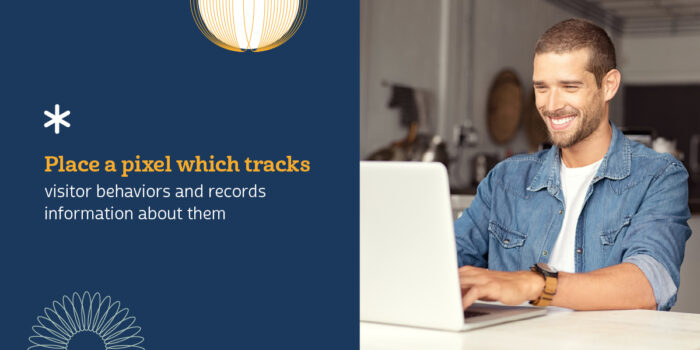
The method you use to collect your first-party data depends on the type of data. To gather behavioral data from your website, app or social media profile, you can place a pixel which tracks visitor behaviors and records information about them. Anytime someone lands on your site, clicks on a link or views a product, you’ll automatically receive that data.
You might also collect offline data, such as purchase data, subscriber information, and survey responses, in offline databases. Combining this data with your online data makes it more powerful. Our end-to-end data collaboration platform, Spherical, helps to bring your offline data online and match it with mobile IDs and online cookies to give you enhanced customer insights.
Collecting all of this data in a data collaboration platform allows you to get a complete view of your customer data. Within your DCP, you can collect and organize, analyze and activate your first-party data and combine it with second-party and third-party data for even deeper insights.
Collect and Manage Your First-Party Data With Lotame
Lotame’s end-to-end data collaboration platform, Spherical, makes it easy to get the most out of your first-party data. Our technology makes it easy to collect data from various online and offline sources, determine the relationships between the various devices used to access your content, and even manage consent information.
You can leverage Lotame’s tools to optimize your audiences and analyze your data with the help of second-party and third-party data from our marketplaces. We also offer API support and unlimited activation channels.
In addition to our industry-leading technology, we also offer world-class support. With Lotame, you can take full advantage of your first-party data to improve your campaigns and content, grow your revenue and better meet your customers’ needs. To learn more about our Data Empowered solutions, contact us today.